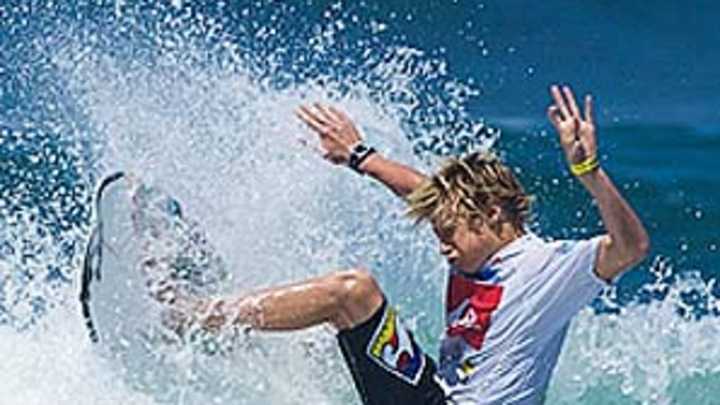The future of American surfing lies in trio of young talent

The sun has yet to peak over the mountains that line the Playa de las FAE, a secluded beach on the Ecuadorian Air Force base in Salinas known for its long waves. Sitting on a bus carrying them through dirt streets to the breaking shores are Kolohe Andino, Connor Coffin and Evan Geiselman, three 15-year-old surfers from different parts of the country that are collectively being hailed as the future of American surfing.
[Click here for video highlights of the trio]
There are a multitude of highlights of the trio surfing online but even the sound of them riding the waves in the dark explains the hype surrounding them. Andino rides each wave as if his surfboard is connected to the shore, smoothly going back and forth before getting off as if he were riding a roller coaster. Coffin punishes each wave, turning his board atop one after another and spraying water in the air like a whale as he crashes through the water. Geiselman is almost a mix of both as he blends artistic surfing with powerful turns, intertwining both styles like a DJ working a turntable.
Nearly 20 years ago a trio of American surfers from the mainland made their mark on the sport with their own unique styles that were as distinctive as the locales they hailed from. There was Kelly Slater from Florida, Rob Machado from Encinitas, about 30 minutes north of San Diego, and Taylor Knox from Thousand Oaks, about 45 minutes north of Los Angeles.
As Slater, Machado and Knox approach their 40th birthdays, these three "groms" (beach lingo for under-16 surfers on the rise) who gathered at the Quiksilver ISA World Junior Surfing Championships, hail from the same areas and represent the future of the sport dominated by Hawaiians (who compete separately from the rest of the United States in surfing competitions), Australians and an eclectic mix from South Africa, France and Brazil.
Like many 15-year-olds would, the trio had a difficult time explaining why they have been tapped to become the future of American surfing. But the consensus amongst those in the Team USA camp -- and certainly amongst their multitude of sponsors -- is that this trio is the best to come from the mainland in at least two decades.
"Back in the '90s surfing had what they called, 'The Momentum Generation' and Slater was at the forefront of that that along with Machado and Knox," says Joey Buran, who coached the U.S. National team during the World Junior Surfing Championships. "Those great Americans that redefined surfing are at the back end of their careers right now but they were fantastic. Well, it's interesting because each of these guys, Kolohe, Connor and Evan, are almost carbon copies of each of those guys."
Buran, who was the top-ranked amateur and pro surfer in California during the late '70s and early '80s, speaks quickly and loudly in the lobby of the team's hotel as he talks about each one of the young surfers and how they compare to their predecessors. "Kolohe is like Slater," he says. "He reads the waves properly and his technical lines are perfect. It's artistically beautiful. It's like a figure skater that wins the gold; he glides like that on a surfboard.
"Connor is all power. To this day if you're power surfer they compare you to Taylor Knox and I saw Taylor when he was 15, 16 and 17, and Connor is just like Taylor. And Evan is creative and new school. He's the Rob Machado of this generation. He's got creativity and instincts and is going to progress the sport with what he does."
While Buran had often said that "these three guys give us a chance to dream of gold," neither was able to win gold during the Quiksilver ISA Championships as Team USA had to once again settle for copper (yes, they have medals for fourth place).
Andino, a six-time National Scholastic Surfing Association (NSSA) national champion, is probably the most visible younger surfer in the States today. He often graces photo spreads in surf magazines and shares the screen with established professionals in surf films. Three-time world champion Andy Irons once said, "It's only a matter of time before the kid rules the world."
Andino, who works daily with his father, Dino, a former U.S. Pro champion, in improving his surfing, looks like any other 15-year-old at the dinner table; laughing with his friends, brushing aside his shaggy blond hair and asking if he could use the restroom. But in the water he rides waves that most twice his age wouldn't dream of conquering.
"Those three kids are going to be the future of professional surfing in the United States," says Chad Wells, a former pro surfer and the Quiksilver Surf Team Manager. "But if you could shrink-wrap a WCT [World Championship Tour] surfer into 15-year-olds body you would come out with Kolohe Andino. He's got good technique, good solid foundation, good looks, he's not only talented but he's super marketable."
Geiselman, whose father, Greg, was also pro surfer and now shapes boards, and Coffin, whose younger brother, Parker, also surfs on Team USA, could become just as marketable if they stay on course. Geiselman, who finished second at the Sebastian Junior Pro, is already being touted as the East Coast's next great surfer, while Coffin, who won the NSSA West Coast Championships, may become the best surfer to come out of Santa Barbara since Tom Curren.
"They're not 'The Momentum Generation.'", says Buran. "That was then and this is now. These three surfers are going to take the sport to new heights. "I'll be shocked if all three of them don't leave [a mark] 20 years from now."
